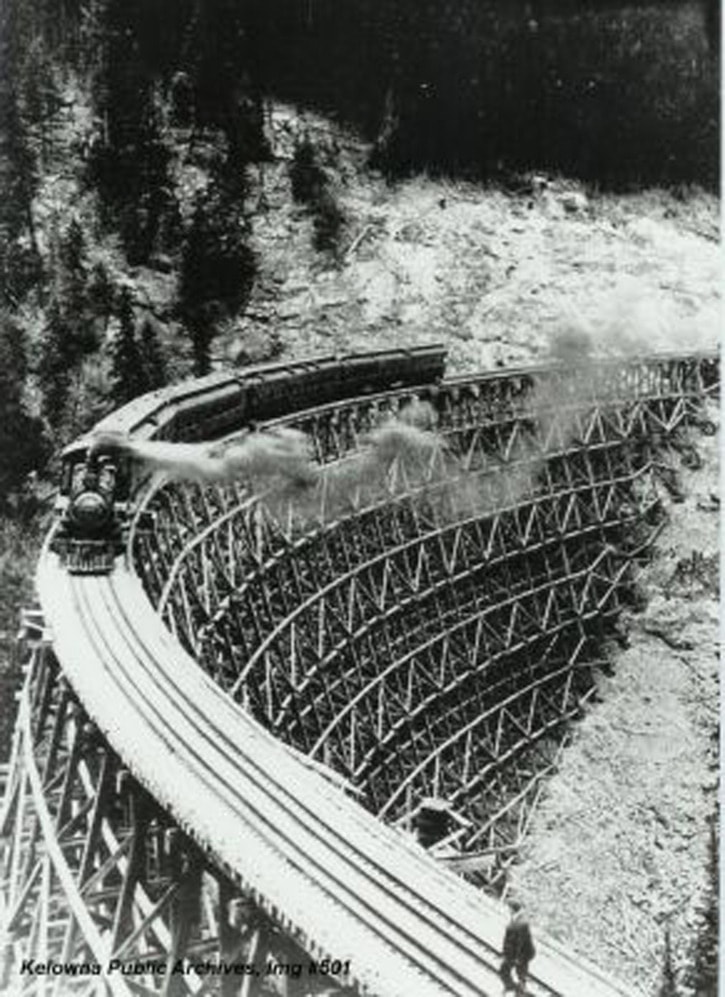Mountain passes, steep valleys, and rugged terrain are the home of the engineering feat known as the Kettle Valley Railway. The Myra Canyon section, famous for its wooden trestles, was the highest pass of rail ever built in Canada. As the Great Northern Railway pushed into the region from the U.S., the Canadian Pacific Railway, through the KVR, began construction on the line that would connect the Kootenays to the coast and secure Canadian control over the area’s wealth. This section of the line, completed in 1914, was known as ‘McCulloch’s Wonder’, an amazing feat of railway construction through the Myra Canyon. Over a distance of only eight and a half kilometres, eighteen trestles and two tunnels were built to carry the rail line across wide gaps and to conform to the curves of the canyon walls. The Kettle Valley Railway officially opened May 31, 1915, with tri-weekly service from Midway to Merrit. The rail line through the Coquihalla to Hope was completed in the summer of 1916. The KVR, constructed almost a century ago, completed its last scheduled run on January 17, 1964. Due to difficulty in upkeep, the rail line was eventually disassembled piece by piece, and the physical legacy of the hard work performed by the railway’s immigrant labourers drifted away into history. Today, the route Myra Canyon is part of the Trans Canada Trail.
The Lake Country Museum is pleased to offer a public presentation and lecture at the Creekside Theatre on the history of the KVR through Myra Canyon and the men who built it. Building the Kettle Valley Railway: Myra and its Men will be presented by Dr. Maurice Williams and Dr. Richard Garvin, of UBCO, who established the Myra Canyon Research Project to uncover the history behind this famous section of the Kettle Valley Railway.
Richard Garvin is an Associate Professor in the Department of Community, Culture, and Global Studies at UBC Okanagan. An archaeologist by training, Dr. Garvin has extensive research experience throughout western North America and Central America, particularly Mexico, where he is currently co-director of the Chihuahua Archaeology Project. Dr. Garvin directed the archaeological component of the 2008 and 2009 UBCO field schools at Myra Canyon, south of Kelowna, BC. During this presentation he will discuss some of the results of these excavations and how they have given us insight into the lives of the men who constructed the railway.
Maurice Williams, Professor of History at UBC Okanagan, taught previously at Notre Dame University of Nelson, Okanagan College, and Okanagan University College, and has published numerous articles and books, including Myra’s Men: Building the Kettle Valley Railway and two books on Central Europe and Austrian National Socialism. Dr. Williams, with Dr. Garvin, established the Myra Canyon Research Project, sponsored by the Myra Canyon Trestle Restoration Society and UBCO, In 2009, Maurice Williams received the UBCO Teacher of the Year award in recognition of his accomplishments. Dr. William’s book, Myra’s Men, available for purchase at the lecture, looks at the men who built the majestic Myra Canyon trestles on BC’s Kettle Valley Railway, accounting for the experience of both the engineers who oversaw the work and the everyday lives of the immigrant labourers who blasted tunnels, laid the tracks and built the soaring trestles.
As well, local artist Margaret Kyle will be on site with note cards and poster prints of her renowned painting, Kettle Valley Trestle 4, for sale.
The lecture will take place 1:30pm on Sunday, April 3, 2011, at the Creekside Theatre.
Doors open at 1:00. Admission is by donation
